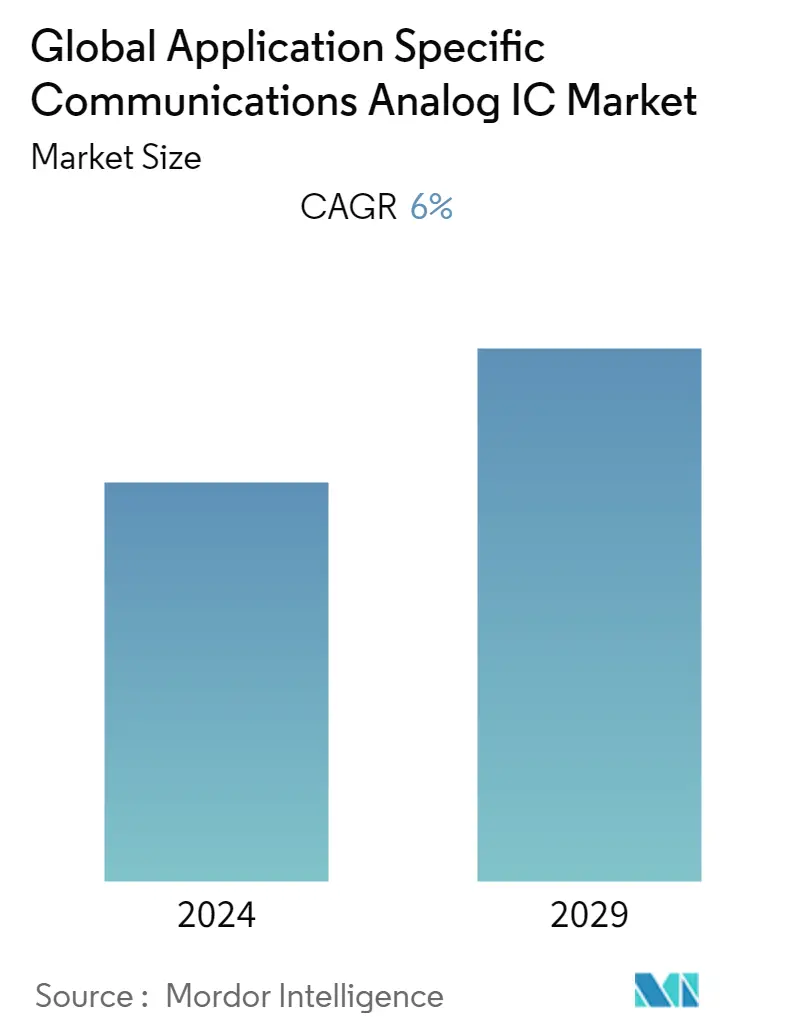Market Size of Global Application Specific Communications Analog IC Industry

| Study Period | 2019 - 2029 |
| Base Year For Estimation | 2023 |
| Forecast Data Period | 2024 - 2029 |
| CAGR | 6.00 % |
| Fastest Growing Market | Asia-Pacific |
| Largest Market | North America |
| Market Concentration | Medium |
Major Players.webp)
*Disclaimer: Major Players sorted in no particular order |
Application Specific Communications Analog IC Market Analysis
The Global Application Specific Communications Analog IC Market is expected to grow by registering a CAGR of about 6% during the forecast period. The growing adoption of advanced technologies such as AI, IoT, and other wireless communication technologies, along with increasing investment in developing new-generation communication solutions, is among the significant factors driving the growth of the analog communication ASICs market.
- Analog communication ASICs are primarily used in telecommunication modules to detect, interpret, and transmit data signals. These ICs support multiple technologies and are designed to reduce the complexity of the electronic communication equipment used for various end-user applications. Furthermore, analog communication ASICs play an essential role in developing portable electronic devices such as mobile phones or navigation systems.
- The Analog ASICs are integral to various communication chips, including cellular modem chips, chip antennas, error correction chips, GPS and GPRS chips, Bluetooth chips, RF transmitters & transceivers, and other network and communication chips.
- With the demand for related products increasing, the communication industry is focusing on developing new connectivity technologies and chips that can facilitate the future requirements of the industry. Furthermore, the development of new-generation telecommunication technologies, such as 5G, is also creating a good market scenario for the growth of the studied market.
- For instance, in December 2021, Ensilica, a U.K.-based custom design house, announced that it is developing the cellular ASIC to support AST SpaceMobile's planned space-based cellular broadband network. AST SpaceMobile is working on a project to build what it claims to be the first global cellular broadband network in space to operate directly with standard, unmodified mobile devices.
- However, with miniaturization being one of the highly prioritized trends in the semiconductor industry, the growing demand for more minor-size chips is expected to challenge the growth of the studied market as scaling down the chip size significantly enhances the designing and production complexity.
- The COVID-19 pandemic significantly impacted the market's growth, as supply chain disruptions, especially during the initial phase of the pandemic, impacted the production capabilities of chip manufacturers. However, on a positive note, the increasing penetration of digital technologies, considerably since the outbreak of the pandemic, has increased the demand for high-band connectivity services across the globe, which is expected to have a long-term positive impact on the studied market.
Application Specific Communications Analog IC Industry Segmentation
The analog communication ASIC market report includes a comprehensive assessment of the market trends, segments, and regional demand/supply overview. The study also outlines an analysis of the future opportunities and trends that may impact its growth. A detailed assessment of the COVID-19 is also a part of the study.
| By Geography (Market Estimations and Projections along with Volume Data) | |
Global Application Specific Communications Analog IC Market Size Summary
The Global Application Specific Communications Analog IC Market is poised for significant growth, driven by the increasing adoption of advanced technologies such as AI, IoT, and wireless communication systems. These analog ICs are crucial in telecommunication modules, facilitating the detection, interpretation, and transmission of data signals while simplifying electronic communication equipment. They are integral to various communication chips, including those used in cellular modems, GPS, Bluetooth, and RF transmitters. The demand for these ICs is further bolstered by the development of new-generation telecommunication technologies like 5G, which necessitates more sophisticated and efficient communication solutions. Despite challenges such as the miniaturization trend in the semiconductor industry, which complicates chip design and production, the market is expected to benefit from the increasing need for high-band connectivity services, a trend accelerated by the COVID-19 pandemic.
The Asia Pacific region has emerged as a significant growth area for the communication industry, driven by digital skill development, expanded cellular coverage, and affordable mobile subscriptions. Rapid industrialization and IT sector growth have attracted foreign investments, enhancing the region's technological exposure. Countries like China are leading in 5G adoption, with other nations expected to follow suit, creating substantial opportunities for the application-specific communications analog IC market. The market is moderately fragmented, with established players like Renesas Electronics, Infineon Technologies, and Texas Instruments holding significant shares, while new entrants are drawn by the growing demand. Recent developments, such as CEVA's introduction of a 5G baseband platform IP and partnerships aimed at advancing 5G and communication system technologies, highlight the dynamic nature of the market and its potential for innovation and expansion.
Global Application Specific Communications Analog IC Market Size - Table of Contents
-
1. MARKET INSIGHTS
-
2. MARKET SEGMENTATION
Global Application Specific Communications Analog IC Market Size FAQs
What is the current Global Application Specific Communications Analog IC Market size?
The Global Application Specific Communications Analog IC Market is projected to register a CAGR of 6% during the forecast period (2025-2030)
Who are the key players in Global Application Specific Communications Analog IC Market?
Renesas Electronics Corporation, Infineon Technologies AG, Microchip Technology Inc., Texas Instruments and Diode Incorporated are the major companies operating in the Global Application Specific Communications Analog IC Market.

